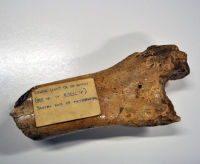Leg bone - Ox or bison
Object
fossil
Object number
1991.1033
Physical Description
A shaft fragment of a broken fossil right humerus (upper forelimb) bone, belonging to Bos sp. 'Stoke Newington 1960' in ink. Identification provided by Prof. Adrian Lister.
Object history
This leg bone belonged to either a prehistoric ox or bison. It was discovered 20ft below the ground during tunnelling operations during September and October 1960 for the construction of the new Evering Road sewer. It was found about 20ft below ground, between Maury Road and the railway bridge.
Reports state that the animal remains found at the site included:
- six complete molar teeth (it is not clear if this includes 1991.381 which is broken) of a Straight Tusked elephant
- the front section of a Jaw of a Straight Tusked elephant
- parts of a skull (see 1991.382) of a Straight Tusked elephant
- fragments of vertebrae of the Straight Tusked elephant
- a rhino atlas vertebra (see Natural History Museum M85344),
- 'the leg bone of a rhino' (potential misidentification of this bone?)
- a metatarsal/ foot bone of a Steppe Bison or Auroch (see 1991.1032)
- the tooth of a wild horse, now in the British Museum.
The finds were made by workmen, and reported to the British Museum by Mr Howard Lewis, an amateur geologist who lived nearby and who made regular visits to the excavation in order to record the deposits exposed there.
Documents related to the discovery are held by the Natural History Museum, Ref. DF PAL/129/5/4/156.
Reports state that the animal remains found at the site included:
- six complete molar teeth (it is not clear if this includes 1991.381 which is broken) of a Straight Tusked elephant
- the front section of a Jaw of a Straight Tusked elephant
- parts of a skull (see 1991.382) of a Straight Tusked elephant
- fragments of vertebrae of the Straight Tusked elephant
- a rhino atlas vertebra (see Natural History Museum M85344),
- 'the leg bone of a rhino' (potential misidentification of this bone?)
- a metatarsal/ foot bone of a Steppe Bison or Auroch (see 1991.1032)
- the tooth of a wild horse, now in the British Museum.
The finds were made by workmen, and reported to the British Museum by Mr Howard Lewis, an amateur geologist who lived nearby and who made regular visits to the excavation in order to record the deposits exposed there.
Documents related to the discovery are held by the Natural History Museum, Ref. DF PAL/129/5/4/156.
Associated Place
Material
bone
Dimension
Height (Whole): 160mm
Width (Whole): 100mm
Depth (Whole): 65mm
Width (Whole): 100mm
Depth (Whole): 65mm
On display?
No
Inscription
Stoke Newington 1960




